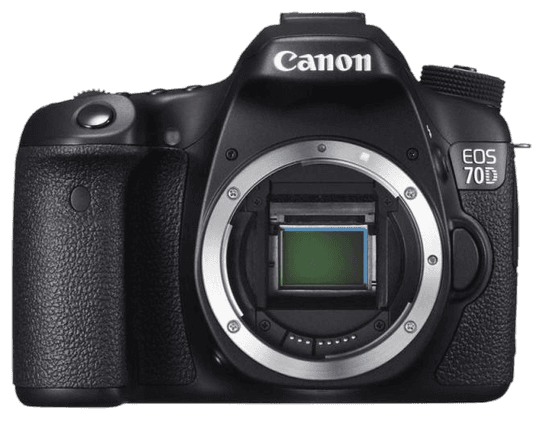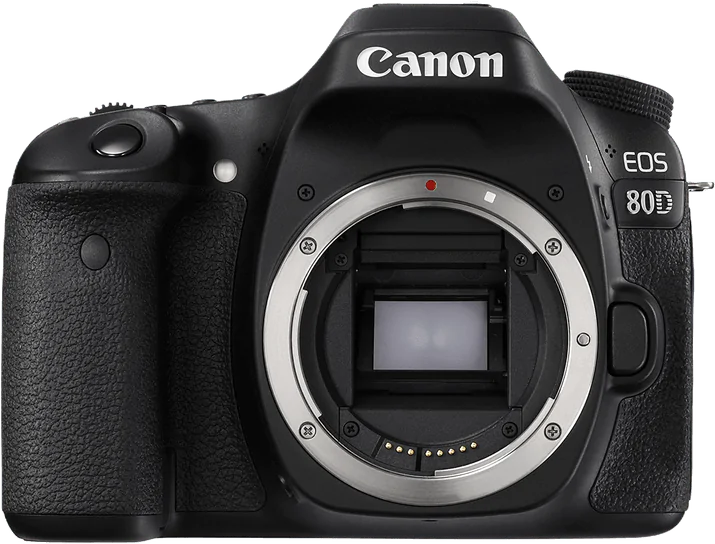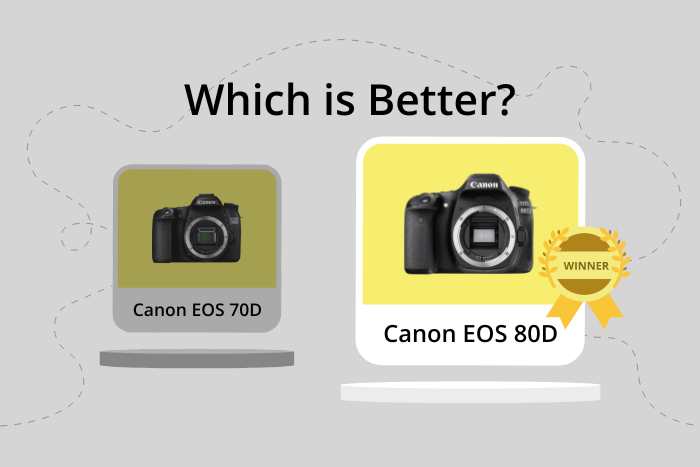Canon EOS 70D vs EOS 80D Comparison
Canon EOS 70D

Canon EOS 80D

The Canon EOS 80D takes the lead with a score of 64/100, while the Canon EOS 70D trails behind with a score of 60/100. Both cameras are DSLR types and have similar launch prices ($1200 for the 80D and $1199 for the 70D). They also have almost identical sizes, with the 80D being just 1mm taller. However, the 80D is slightly lighter, weighing 730g, compared to the 70D’s 755g.
The 80D’s higher score can be attributed to its improved features and newer release year (2016). On the other hand, the 70D, released in 2013, may still hold some advantages due to its lower price and slightly more compact size. Both cameras have their merits, but the 80D’s higher score and lighter weight make it a more appealing option for many photographers.
Canon EOS 70D vs EOS 80D Overview and Optics
The Canon EOS 80D wins in the optics comparison with a score of 63/100, whereas the Canon EOS 70D scores 58/100. Both cameras share some common specifications, such as a shooting speed of 7 frames per second, a CMOS sensor type, an APS-C sensor size, a Canon EF-S lens mount, and no image stabilization.
The EOS 80D outperforms the 70D in several aspects. It boasts a higher megapixel count of 24.2, compared to the 70D’s 20.2 megapixels, allowing for more detailed and sharper images. Additionally, the EOS 80D has a more advanced processor, the Digic 6, while the 70D uses the Digic 5+ processor. This results in better image processing capabilities and overall improved performance. Furthermore, the 80D’s sensor has a higher DXOMARK score of 79, compared to the 70D’s score of 68, indicating better image quality and dynamic range.
On the other hand, the Canon EOS 70D does not have any significant advantages over the 80D in terms of optics. The only aspect where the 70D matches the 80D is in the shared specifications mentioned earlier.
Considering the differences in the optics, it is evident that the Canon EOS 80D is a superior camera compared to the EOS 70D. With its higher megapixel count, advanced processor, and better sensor DXOMARK score, the 80D delivers improved image quality and performance. While the 70D is still a capable camera, the 80D’s enhancements make it the better choice for photographers looking for better results in their images.
Canon EOS 70D vs EOS 80D Video Performance
The Canon EOS 80D outperforms the Canon EOS 70D in terms of video capabilities, with a video score of 70 out of 100 compared to the 70D’s score of 43. Both cameras share the same maximum video resolution of Full HD and video dimensions of 1920 x 1080, but the 80D boasts a higher maximum video frame rate and time-lapse functionality.
The 80D’s superior video performance is mainly due to its maximum video frame rate of 60fps, which is double the 70D’s 30fps. This allows for smoother and more detailed footage, especially in fast-paced scenes or when capturing slow-motion video. Additionally, the 80D has a built-in time-lapse functionality, enabling users to create stunning time-lapse videos without the need for additional equipment or software.
While the 70D falls short in terms of frame rate and time-lapse capabilities, it still offers Full HD video resolution and 1920 x 1080 video dimensions, ensuring that users can capture high-quality video footage. However, the lower frame rate may be limiting for those who require smoother video or slow-motion capabilities.
To summarize, the Canon EOS 80D is the clear winner in terms of video capabilities, offering a higher video score, double the maximum video frame rate, and built-in time-lapse functionality. The 70D, while still capable of capturing high-quality video, is limited by its lower frame rate and lack of time-lapse features. Users who prioritize video performance should opt for the 80D, while those who can work within the limitations of the 70D may still find it sufficient for their needs.
Canon EOS 70D vs EOS 80D Features and Benefits
The Canon EOS 70D and Canon EOS 80D both have a feature score of 70/100, making them equal in this aspect. They share several specifications, including a 3-inch screen size, a screen resolution of 1040000 dots, touchscreen capabilities, a flip screen, and built-in WiFi. Neither camera has GPS or Bluetooth.
Despite having the same feature score, there are some differences between the two cameras. The Canon EOS 80D is better in terms of autofocus performance, offering 45 autofocus points compared to the 70D’s 19 points. This means that the 80D can focus more accurately and quickly on a subject, making it ideal for capturing fast-moving objects or events.
On the other hand, the Canon EOS 70D has a slightly faster continuous shooting speed of 7 frames per second (fps) compared to the 80D’s 6 fps. This advantage allows the 70D to capture more images in a shorter amount of time, which can be useful for action photography or capturing fleeting moments.
Both cameras have their strengths and weaknesses, but neither camera is significantly better than the other in terms of features. The Canon EOS 80D’s superior autofocus performance may be more appealing to photographers who prioritize fast and accurate focusing, while the Canon EOS 70D’s faster continuous shooting speed might be more attractive to those who need to capture fast-paced action. Ultimately, the choice between these two cameras depends on the specific needs and preferences of the photographer.
Canon EOS 70D vs EOS 80D Storage and Battery
The Canon EOS 80D outperforms the Canon EOS 70D in storage and battery with a score of 43/100 compared to the 70D’s 37/100. Both cameras have one memory card slot and do not support USB charging. They also accept SD, SDHC, and SDXC memory cards. However, the 80D is compatible with faster UHS-I cards, providing a slight advantage in storage performance.
Regarding battery life, the 80D lasts for 960 shots, which is 40 more than the 70D’s 920 shots. The 80D uses an LP-E6N battery type, while the 70D relies on an LP-E6 battery. The difference in battery types contributes to the 80D’s longer battery life.
The 70D does not have any distinct advantages in storage and battery over the 80D. Consequently, the Canon EOS 80D emerges as the better choice for photographers who prioritize longer battery life and faster storage performance.
Canon EOS 70D vs EOS 80D Alternatives
Still not sure which camera is best for you? Check out these popular camera comparisons for inspiration:
- Canon 7D vs 60D
- Canon 90D vs 7D Mark II
- Canon 70D vs T6s
- Canon 60D vs 70D
- Canon Rebel T6i vs T6s
- Canon 700D vs 60D
- Canon T6 vs T6i

